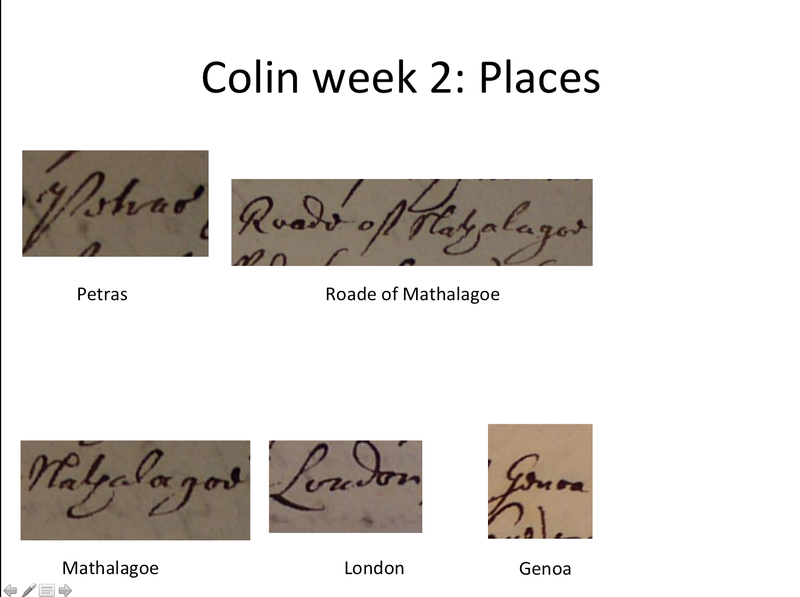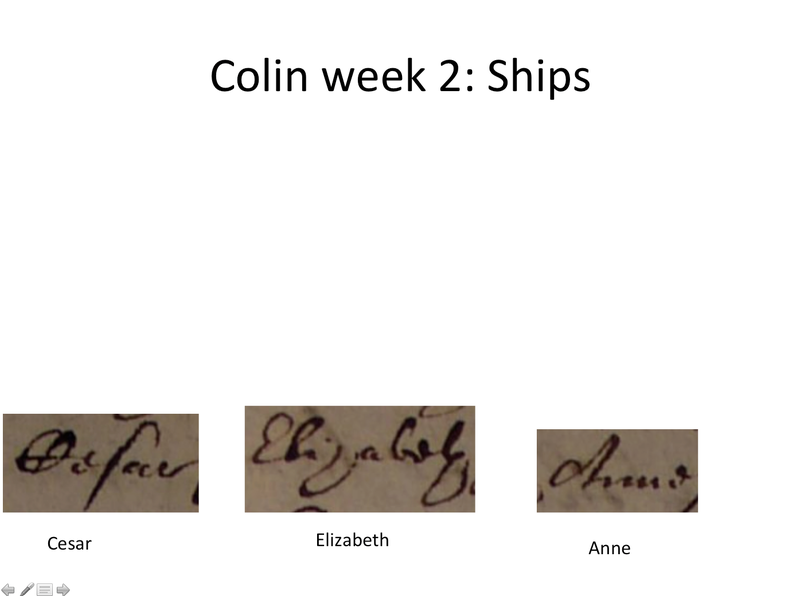Difference between revisions of "Team Colin"
| Line 72: | Line 72: | ||
[[File:colinweek2freight.png|right]] | [[File:colinweek2freight.png|right]] | ||
---- | ---- | ||
| − | ===Week commencing September 17th (week two of | + | ===Week commencing September 17th (week two of transcription)=== |
---- | ---- | ||
====Interesting places==== | ====Interesting places==== | ||
Revision as of 07:10, September 18, 2012
Team Colin
Editorial history
23/08/12: CSG, created page
Contents
- 1 Suggested links
- 2 Tasks for the week
- 3 TIPS from Colin
- 4 QUERIES FROM COLIN GREENSTREET
- 5 QUERIES FROM ALEX JACKSON
Suggested links
Page log
Team Jill
Team William
Team Giovanni/Patrizia
MarineLives-Transcript: Team Colin
Tasks for the week
Week commencing 20th August 2012
- 19/08/12: Uploaded four images (HCA 13/71 f.19r, f.19v, f.20r, f.21r)
- These are images for palaeography practise by all MarineLives team members
- 22/08/12: Uploaded twenty seven images (HCA 13/71 f.21v-f.34v)
- These are additional images for palaeography practise by all MarineLives team members
Week commencing 30th August 2012
Week commencing 3rd September 2012
Week commencing 10th September 2012
Notes and help for Colin week 2 HCA 13/71 f.80r to HCA 13/71 f.89r
Below you can find some slides with common names, places, ships, and words that come up in this set of documents. You can also find an alphabet made from clippings from that set of documents.
Alphabet
Names
Places
10/09/12: Mathalagoe in slide below is possibly "Nathalagoe" (Colin Greenstreet)
- Can an associate or a facilitator find it on a map and identify what the modern name is for this place?
Ships
Common Words
Week commencing September 17th (week two of transcription)
Interesting places
Horsey down
Horsey down appears in a law suit over the failure to pay the wages of the shipwrights and shipcarpenters for the repair of a ship called the Swan (formerly the Satisfaction) The boat was being repaired at the personal wharf of John Mayor: "his key is neer the horsey downe new staires", which was on the Thames. (HCA 13/71 f.138r P1130442)
But where was or is Horsey down?
- There is a modern Horsey down in Wiltshire, but the one in HCA 13/71 f.138r is clearly on the Thames. Looking at John Strype's Survey of the Cities of London and Westminster helps us focus our search. The online academic edition of Strype's book is easily searchable, and yields the following entry:
"The TEMPORAL GOVERNMENT. [Maiors and Sheriffs.]
A.D. 1683. } { Peter Daniel, Haberdasher.
35 Car' II. } Sheriffs, [ Click here to view Image of coat of arms, Sir William Pritchard ] { Sam. Dashwood, Vintner.
MAIOR, Sir William Pritchard, Mercht. Taylor,
Son of Francis Pritchard of Horsey-Down in Southwark, Surrey."[1]
- Knowing that Horsey down, or "Horsey-down", was in Southwark, helps a lot with the next search, which yields the following entry on an online numismatic site called 'British Farthings'
"Horslydown (or Horsey Down): So called from its having been used as a grazing place for horses"[2]
The farthings listed under this entry include:
"W267: Southwark, Horslydown (or Horsey Down) (Farthing): (1657)
O Three sailors
AT YE 3 MARRINERS IN
R R S S
HORSSE DOWNE 1657 R S S"
and
"W271: Southwark, Horslydown (or Horsey Down) (Farthing): (Date Unknown)
O [Blank]
THE GREEN MAN AT
R W T V
HORSEN DOWNE STARES W T V"
The second farthing, with its mention of "Horsen downe stares", together with the maritime theme of the first farthing, suggests that at least part of Horsey down was on the River Thames (as was suggested in the extract from HCA 13/71 f.138r, which started this search ("his key is neer the horsey downe new staires")
- Now to some secondary sources.
Edward Walford in volume 6 of Old and New London (London, 1878) provides a description of Tooley Street, in Bermondsey, Southwark. This is available at British History online.[3]
Reading this entry, it is soon apparent that prior to 1733, Horsey down, also known as Horselydown, was a district of the Southwark parish of St. Olaves. St. Olaves church being located on the north side of Tooley Street. Following the building of its own church in 1732, Horsey down became an independent parish, known as the parish of St. John.
Walford, reviewing early seventeenth century accounts of the derivation of the name, includes the observation:
"speaking of the derivation of the name of Horselydown, the author of "A New View of London" (1708), remarks: "This street, as I was told by a sober counsellor at law, who said he had it from an old record, was so called for that the water, formerly overflowing it, was so effectually drawn off that the place became a green field, where horses and other cattle used to pasture and lye down before the street was built." Near it, as we further learn from the same work, was Horselydown Fair Street, described as a considerable street, between Paris Street, Tooley Street, and Five Foot Lane, Southwark."
Modern map of Tooley Street
Interesting people
Interesting commodities
TIPS from Colin
Common words that may prove difficult
- Contest; precontest
- Rendent
- y:t (transcribe this as "that")
- y:m (transcribe this as "them")
Legal language
- Note that you answer to an interrogatory, but depose to the articles of an allegation (allon)
- Note that deponents are often asked whether they have an interest in the cause and whether they are otherwise concerned with the matters, to which they usually reply that they favour only the truth
- vizt
QUERIES FROM COLIN GREENSTREET
13/09/12
- Does anyone know what "dennage" means, and what the related to be "Dennys" for goods means.
- See:
19. And this Rendent did often urge the sayd Masters to be gone, and one of them
20. vizt William Shrotch sayd positively he would not till he had further order
21. from his Owners, which he pretended to expect from Dublin, and refused
22. to signe the bills of lading, pretending he was Master for the shipp, and Dennys
23. for the goods
(HCA 13/71 f.162r P1130491)
Earlier
- HCA 13/71 f.19v Completed by Colin – please would someone check
- HCA 13/71 f.21r Started by Colin - please would someone finish
- HCA 13/71 f.22v P1080930
- Line 3: "hee saith he ćannot depose"
Question: is the acute accent over the "c" or over the "a". This problem is a very frequent one on most manuscript pages
- Contrast with Line 7: "otherwise he cánnot depose." (HCA 13/71 f.24v P1080934)
- HCA 13/71 f.24r P1080933 Started by Colin - please would someone finish
- "Samuel Dun of Limehouse in the County of Midds Mariner late cheife
masters mate and Steevador on board the shipp Thomas Bonadventure
Capt Hughes Commander the voyage in question, aged 36 yeares..."
- HCA 13/71 f.24v P1080934 Started by Colin - please would someone finish
QUERIES FROM ALEX JACKSON
- 13/71 f.82r P1130365 Started by Alex - Please refer to the first line: Have I got the name 'Currans' correct? Also, can anyone work out what the word immediately infront of it is? Is it Gulyle? Is this a first name?
- COLIN: "Currans" is correct (= modern "currants": word infront of it is "Gulphe", For examples of the usage of "Currans" and "Currants" see Commodities
13/71 f.82r P1130365 Started by Alex - Also, attached to the word deposed (apparently attached) on lines 1 and 5 are what appear to be a 'p' and an 'e', but this doesn't work. Might it be 'pre'deposed? If so, could somebody explain why?
- COLIN: The word is indeed "predeposed", and means that the witness has already deposed on the matter, and is referring back to it. Clerks often ommitted the "e" in "pre", writing "prdeposed". Our editiorial convention is to expand the contracted form, inserting the missing letter in italics, as in "predeposed". For legal commercial terms in HCA documents see Legal & Commercial Terms
- 13/09/12: Started by Alex - Please refer to lines 5 and 8 on HCA 13/71 f.70v and lines 16 and 35 on HCA 13/71 f.82r. Is the place name Potrao? It continues to look like that to me, but I don't find that name in the section 'Geographical and Place Terms' so I suspect I'm reading it wrong. There is a 'Poltrao' in that section, but I can't see an 'l'. Any suggestions?
- COLIN:
(1) I have looked at lines 5 and 8 of HCA 13/71 f.70v P1130342 and lines 16 and 35 of HCA 13/71 f.82r P1130365. In the case of lines 5 and 8 you are misreading: it is "PetraX" with the X either an "o", or possibly an "s"; in the case of lines 16 and 35 it is again "PetraX". In line 16 you can clearly see that it is an "e" if you look three words to the right to "Cesar" (a ship's name", where the "e" of "Cesar" is identical to the "e" of "PetraX"
(2) See "Poltrao (the Road of ?Poltrao" (HCA 13/73 Part Two))" in Geographical and Place Names: P. I have not rechecked my original transcription of "Poltrao", and I may myself have been wrong with this spelling. I suspect this is the same place as your reading of "Potaro", but there are also other spellings
(3) See also a SKYPE conversation I had today with Jill Wilcox, who had a similar question:
[15:20:08] jill wilcox: Hi colin there a place in the notes for colin week 2 which is transcribed as petras, do you know where this is?
[16:06:33] Colin Greenstreet: It is either Petrao or Petras, and I think it is in the area in the Greek islands called Morea, see: Early nineteenth century description of Venice to Morea and onwards trade (http://bron.wikispot.org/Zante#head-57612aa08d517d203248b1ab90c7ddd144c70a4e)
[16:07:12] Colin Greenstreet: Infact, looking at that URL, I see a place called "Petrasso" . "Currants, it has been observed, are a considerable article of export from the Morea; Petrasso is one of the best ports to ship them from; the fruit is rather larger and more free from and or gravel, than that of either Zante or Corfu. They are shipped in various sized casks, from twenty hundred weight to fifty pounds. The quantity shipped must weight above five hundred weight net, otherwise, they are liable to seizure. The casks are always included in the weight of the fruit, and paid for as such; the Morea currants have the preference in most countries, except England, where the Zante currants are more merchantable."3"
[16:10:47] jill wilcox: karen thought it might be patras which is a place in Greece, and on the coast
[16:11:43] Colin Greenstreet: That is possible. If it is mentioned in the context of currants it is likely to be Petrasso as above, but that could also be the place called Patras Karen has identified"
- 13/09/12: Started by Alex - Please refer to lines 22 and 24 on HCA 13/71 f.70v '. There appear to be brackets in the text. How do I insert this punctuation?
- COLIN: I presume you mean the curved brackets "(...)" as in the snippet below. I have very occasionally seen square brackets "[..]". I would render curved or square brackets as curved or square brackets. You can type curved brackets straight into the text input box. With square brackets, go to MS-Word and go to Insert Symbol. Find square brackets and insert them into a blank MS-Word document, then copy and paste them into the MarineLives-Transcript text input box. You can zse this Insert Symbol approach via MS-Word for a huge range of characters

- ↑ Strype, Survey of London (1720), [online] (hriOnline, Sheffield). Available from:- http://www.hrionline.ac.uk/strype/TransformServlet?page=book5_150&display=normal Accessed 9.9.2005
- ↑ http://www.britishfarthings.com/Tokens/17th-Century/Southwark/Horslydown.html, accessed 18/09/12
- ↑ http://www.british-history.ac.uk/report.aspx?compid=45269, accessed 18/09/12






